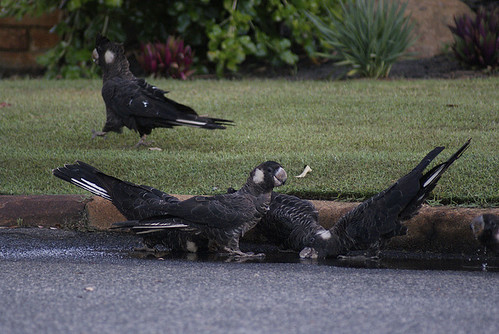 Thirsty Carnaby's cockatoos landing in suburbia to get a drink. Image by Delia AnthonyRecord temperatures are being blamed for the deaths of scores of birds in Western Australia's south.
Thirsty Carnaby's cockatoos landing in suburbia to get a drink. Image by Delia AnthonyRecord temperatures are being blamed for the deaths of scores of birds in Western Australia's south.
The Department of Environment and Conservation (DEC) says it is investigating the deaths of more than 100 rare black cockatoos at Hopetoun, on the south coast, and more than 50 other birds 75km east of the township.
The dead birds have been found over two days since Wednesday, when the state's south sweltered through temperatures of up to 53 degrees Celsius.
On the hottest day since records were kept, temperatures in the Hopetoun area touched 47 degrees, while temperatures exceeded 50 degrees Celsius in the area around Mungilup, where the other birds were found.
DEC Nature Protection Branch manager Kevin Morrison said more than 100 white-tailed black cockatoos, most of them the rare Carnaby's species, were found around Hopetoun.
Another 37 were found at Mungilup, along with six regent parrots, two galahs, three mudlarks, three ravens, four yellow throated miners and one kestrel.
He said while heat was the likely cause of the deaths, the DEC would rigorously investigate any other possible causes through autopsies, laboratory tests, site inspections and interviews with witnesses.
He said it was unlikely any link would be found to the 2006-2007 lead poisoning scandal at Esperance, 150km to the east, where thousands of birds were reported to have "fallen out of the sky".
The Esperance Port Authority was fined $500,000 for causing lead and nickel pollution that poisoned children and killed at least 400 birds.
"The suspicion at this stage is that the birds did die of heat stress because it occurred on a day of very high temperatures and very strong northerly winds in the area and it seems this just tipped the birds over the edge," Mr Morrison said.
"Other factors, such as poisoning, may have contributed to the deaths and this will be examined thoroughly when the birds, along with soil and vegetation samples, are brought to Perth for analysis."
Mr Morrison said white-tailed black cockatoos were a threatened species under the Wildlife Conservation Act.
Biological data regarding the age, sex and breeding status of the dead birds would be collected to provide an insight into the impact their loss may have on the survival of the local population, he said.